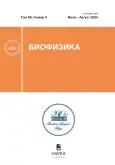Increased Drug Resistance in Acute Lymphoblastic Leukemia Cells in Three-Dimensional High-Density Cell Cultures
- Authors: Shtatnova D.Y.1, Kobyakova M.I1,2, Lomovskaya Y.V1, Fetisova E.I1, Krasnov K.S1, Fadeev R.S1
-
Affiliations:
- Institute of Theoretical and Experimental Biophysics, Russian Academy of Sciences
- Research Institute of Clinical and Experimental Lymphology – Branch of the Institute of Cytology and Genetics Siberian Branch of the Russian Academy of Sciences
- Issue: Vol 69, No 4 (2024)
- Pages: 805-809
- Section: Cell biophysics
- URL: https://journals.rcsi.science/0006-3029/article/view/264945
- DOI: https://doi.org/10.31857/S0006302924040129
- EDN: https://elibrary.ru/NGGKKX
- ID: 264945
Cite item
Full Text
Abstract
About the authors
D. Yu Shtatnova
Institute of Theoretical and Experimental Biophysics, Russian Academy of SciencesPushchino, Russia
M. I Kobyakova
Institute of Theoretical and Experimental Biophysics, Russian Academy of Sciences; Research Institute of Clinical and Experimental Lymphology – Branch of the Institute of Cytology and Genetics Siberian Branch of the Russian Academy of Sciences
Email: ritaaaaa49@gmail.com
Pushchino, Russia; Novosibirsk, Russia
Y. V Lomovskaya
Institute of Theoretical and Experimental Biophysics, Russian Academy of SciencesPushchino, Russia
E. I Fetisova
Institute of Theoretical and Experimental Biophysics, Russian Academy of SciencesPushchino, Russia
K. S Krasnov
Institute of Theoretical and Experimental Biophysics, Russian Academy of SciencesPushchino, Russia
R. S Fadeev
Institute of Theoretical and Experimental Biophysics, Russian Academy of SciencesPushchino, Russia
References
- Terwilliger T. and Abdul-Hay M. Acute lymphoblastic leukemia: a comprehensive review and 2017 update. Blood Cancer J., 7 (6), e577 (2017). doi: 10.1038/bcj.2017.53
- Ekpa Q. L., Akahara P. C., Anderson A. M., Adekoya O. O., Ajayi O. O., Alabi P. O., Okobi O. E., Jaiyeola O., and Ekanem M. S. A review of acute lymphocytic leukemia (ALL) in the pediatric population: evaluating current trends and changes in guidelines in the past decade. Cureus, 15 (12), e49930 (2023). doi: 10.7759/cureus.49930
- Inaba H. and Mullighan C. G. Pediatric acute lymphoblastic leukemia. Haematologica, 105 (11), 2524–2539 (2020). doi: 10.3324/haematol.2020.247031
- Ma C., Witkowski M.T., Harris J., Dolgalev I., Sreeram S., Qian W., Tong J., Chen X., Aifantis I., and Chen W. Leukemia-on-a-chip: Dissecting the chemoresistance mechanisms in B cell acute lymphoblastic leukemia bone marrow niche. Sci. Adv., 6, eaba5536 (2020). doi: 10.1126/sciadv.aba5536
- Dander E., Palmi C., D'Amico G., and Cazzaniga G. The bone marrow niche in B-cell acute lymphoblastic leukemia: The role of microenvironment from pre-leukemia to overt leukemia. Int. J. Mol. Sci., 22 (9), 4426 (2021). doi: 10.3390/ijms22094426
- Hoffbrand A. V. and Pettit J. E. Clinical Hematology (Mosby, Incorporated, 2000), vol. 2, p. 408.
- Jo Y., Choi N., Kim K., Koo H. J., Choi J., and Kim H. N. Chemoresistance of cancer cells: requirements of tumor microenvironment-mimicking in vitro models in anti-cancer drug development. Theranostics, 8 (19), 5259–5275 (2018). doi: 10.7150/thno.29098
- Sabelstrom H., Quigley D. A., Fenster T., Foster D. J., Fuchshuber C. A. M., Saxena S., Yuan E., Li N., Paterno F., Phillips J. J., James C. D., Norling B., Berger M. S., and Persson A. I. High density is a property of slow-cycling and treatment-resistant human glioblastoma cells. Exp. Cell Res., 378 (1), 76–86 (2019). doi: 10.1016/j.yexcr.2019.03.003
Supplementary files










